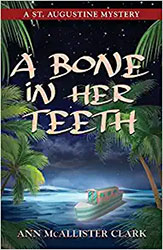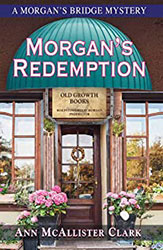Ann’s Cottage Blog
Author Ann McAllister Clark - muses about books, authors and St. Augustine, Florida
Where the Crawdads Sing, by Delia Owens
 Book Review – September 2018
Book Review – September 2018
Literary Fiction/Womans Fiction
Where the Crawdads Sing, by Delia Owens
G.P. Putnam’s Sons, Aug , 2018
One word comes to my mind after reading this book – Wonderful – and all that that word implies. I read the book in two and a half days not because it was a fast read but because it drew me in almost immediately and at the turn of each page I wanted to know more and what would happen next.
Although Where the Crawdads Sing is her first and debut novel, Delia Owens is not at all new to creating stunning literature having co-authored three non-fiction, best selling, lyrical nature books with her husband Mark Owens when they as wildlife scientists lived in and wrote their memoirs about Africa: Cry of the Kalahari, The Eye of the Elephant, and Secrets of the Savanna.
In Where the Crawdads Sing, Owens writes about seven year old Kya abandoned and growing up in the swamps and marshes of coastal North Carolina. This is the coming-of-age story of a girl living alone moving into womanhood. She is helped by a few but not many. The book is also a mystery story, a nature expose and a love story. I learned much about the nature surrounding coastal marshes and isn’t that what we want in our reading, to finish a satisfying story while realizing that the author has subtly taught us something we did not know or had not considered before? The book is filled to the brim with the meanness of prejudice, sweetness of love, forgiveness and the tenacity of the human spirit.
This really is a story full of wonder and I can easily recommend it.
Sue Grafton
I was saddened to hear of the passing of American mystery writer, Sue Grafton just after Christmas, December 28, 2017. Her Alphabet books have been so well received over the years and several of them were inspiration for movies. Ms Grafton’s books began with A is for Alibi and ended with Y is for Yesterday.
A bookstore owner friend of mine here in St. Augustine formed a friendship with Sue Grafton over the years and when he traveled to California to visit family, he often arranged to meet Ms Grafton at one of her book signings to have his growing collection of her books signed. She was always friendly and approachable and he enjoyed this friendship until his death a few years ago.
I know her family knows how she afforded so many of us mystery lovers hours of pleasure as we became friends with her characters, her main character private investigator Kinsey Millhone, enjoyed her fictional town of Santa Teresa and rode the ribbons of her story telling.
Her books will live on for decades of readers enjoyment.
Many of her witty quotes can be found on Google and elsewhere but I find these three bring a smile.
“Ideas are easy. It’s the execution of ideas that really separates the sheep from the goats.”
“I focus on the writing and let the rest of the process take care of itself. I’ve learned to trust my own instincts and I’ve also learned to take risks.”
And finally, “If high heels were so wonderful, men would be wearing them.”
Thank you, Sue Grafton for many hours of fun, interest and escape.
Eloise Wilken – author, illustrator and designer
Eloise Wilkin, author, illustrator and doll designer
By Ann McAllister Clark
Back during the Gulf War it was said that folks were sitting down to watch the children’s television show, Mr. Roberts’ Neighborhood, with their children. It was comforting to watch a placid program that could be counted on to just give calm, soothing sounds, sights and welcoming words and simple ideas of family and friendship.
Now, after all these years we are still inundated with our ‘way-of-the-world’ news. Sometimes it is just too much to take in and process. We have to turn off the TV news. You are lucky if you have a child close by in your life. Pick up a Little Golden Book and give yourself and the child a rest from the chaos of the world.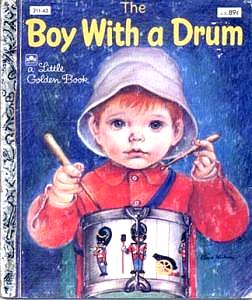 And if you don’t have a little one around go ahead anyway and look through some of the most wonderful stories and illustrations of childhood.
And if you don’t have a little one around go ahead anyway and look through some of the most wonderful stories and illustrations of childhood.
Illustrators like Garth Williams of the Little House on The Prairie books wrote and illustrated for Little Golden Books, as did hundreds of others. Richard Scarry, Gustaf Tenggren and many more contributed to the essence of these little books.
I thought of these books when I wrote the Civil War Saber chapter in my book Morgan’s Redemption of the girl students listening to Lil’ Mary’s stories while they ate their lunch under the big tree out in the school yard. Of course they did not have these happy little books in the 1800’s so their imagination was needed to entertain their listeners. And Lil’ Mary had a head full of imagination developed with the stories of her mother and grandmother. https://www.amazon.com/dp/1495803023/ref=rdr_ext_tmb
One of my favorites was The Taxi That Hurried, written just a year after WWII when people again wanted peace in their lives. It is a cheery little book about a taxi in a busy city. But, then I did love my brother’s copy of The Animals of Farmer Jones with the cows and the chickens and the ducks. The last page was ripped out but I didn’t care.
Steve Santi, has written several definitive collector’s identifications and value guides on the Little Golden Books. I have the 1989 issue that has The Poky Little Puppy on the cover. There have been several new editions since. His web site is a delight and well worth your visit. http://www.thesantis.com/home.htm
Now as an adult, I realize the importance of these books in our lives. And I seem to think of the books several times lately. I turn off the television and forgo reading the headlines. I look through Santi’s book and remember. I remember my mother reading about The New Baby, and Good Morning, Good Night illustrated by Eloise Wilkin. I wanted to find out more about this woman who wrote and illustrated more than 100 books in her lifetime.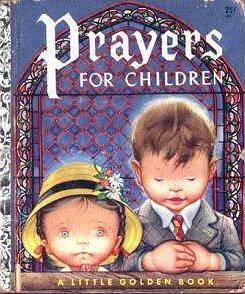
As popular illustrator Tasha Tudor did, Eloise Wilkin spread her creative talents into other venues. She designed a baby doll for Vogue Dolls that has been listed as one of their most favored dolls. It has the same characteristics that her book children have; rounded cheeks, bright eyes filled with trust and wonderment. I saw one of these dolls on E-bay – the Baby Dear doll was listed for a fair price to go along with a copy of the So Big book.
 The books command prices from ten to several hundred dollars in very good condition. The Eloise Wilkin Treasury; a delightful book filled with the artists’ cherubic faces and sweet stories, favorite nursery rhymes, prayers, and poems is currently at $60.00 to $75.00.
The books command prices from ten to several hundred dollars in very good condition. The Eloise Wilkin Treasury; a delightful book filled with the artists’ cherubic faces and sweet stories, favorite nursery rhymes, prayers, and poems is currently at $60.00 to $75.00.
What kind of a woman wrote and illustrated these famous old stories still popular and important in the book collector world today?
Born in Rochester, New York in 1904, Eloise Burns became an illustrator after graduating from The Rochester Institute of Technology. Little is know of her early life but she was fortunate to have had a mother who seemed to be a free spirit and encouraged her children to enjoy their creative gifts. One fine day she allowed them to draw all over one wall in their house just before redecorating. Imagine the squeals and happy scribbles that day.
After she graduated, Eloise and her friend Joan Esley, another illustrator, moved to New York City where they decided they had a better chance of success in the world of illustration. They would later corroborate on several children’s books.
Eloise Burns became Eloise Burns Wilkin in 1935 after her marriage to Sydney Wilkin and soon began a family of four children. She illustrated over 20 books with her sister Ester, who also married a Wilkin.
In 1943, she was offered a contract with Simon & Schuster in New York. She signed to do four Little Golden books a year staying with Little Golden Books exclusively until 1961, then only occasionally doing a book for them up until the mid-eighties.
On October 4, 1987, at the age of 84, Eloise died of cancer in Brighton, New York, bringing an end to a beautiful and fulfilling career and leaving a legacy of delightful stories and pictures still loved by 21st century children and the folks who read to them. At the time of her death Eloise Wilkin was still illustrating and working on a new doll design.
Beatrix Potter
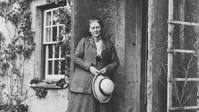
Beatrix Potter
by Ann McAllister Clark
Wouldn’t you think that it would be easy – EASY to sell Peter Rabbit to publishers? Well, before he became a household name to any little tykes between the ages of two and twelve he was not an easy sell.
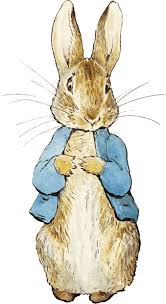
Not until Beatrix Potter, the author and artist who created Peter and all his cohorts was into her thirties did she even think of publishing a book. All her drawings were collected and stored away only hopping out to pretty up a note to a nephew or a young friend who she thought needed cheering up. With a little encouragement she finally gathered enough of her artwork to approach publishers with an idea of writing a ‘tale’ for little children. And can you believe it? She could not find anyone, not one publisher to print her work. She had studied biology, anatomy and art all her life. She created little characters that charmed her young friends and family but she could not charm publishers enough to take a chance on her and Peter Rabbit. So she did what so many other frustrated writers did. She published the book herself. On a cold December day in 1901 Beatrix Potter had two hundred and fifty copies printed. She promptly gave most of the books away. Now that the little rabbit was in book form it wasn’t long before a company in London, Frederick Warne and Company did take notice.

Norman Warne, the youngest of the three Warne brothers in the company dealt most frequently with Miss Potter. She trusted him and to him she took all her ideas and drawings. He was treated to her proofs before anyone else viewed them. He made sure that her ideas and creations were carried out to her exact directions. He was the person with whom she discussed her contracts. And he was the one that finally persuaded the Warne firm to publish an edition that was colorized. That edition was The Tale of Peter Rabbit. At publishing time, October 2, 1902, there were eight thousand copies that promptly sold out.
Not completely trusting the Warne publishing firm’s leader, Fredrick Warne, Beatrix decided to publish her second book herself. She wanted her pictures to be accompanied by many of the rhymes she loved so much. She thought he might cut these and put words to the pictures himself. With the money she had earned with The Tale of Peter Rabbit, she published five hundred copies of The Tailor of Glouster. 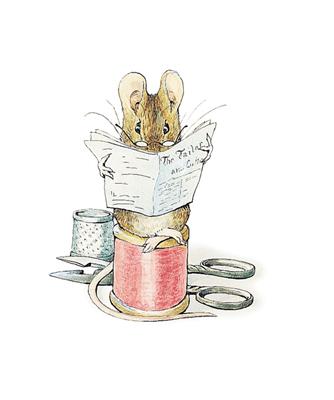 She distributed these herself and sent one copy to Norman Warne. Finally, the Warne company saw her vision and published The Tailor of Glouester in time for Christmas, 1903. Two months later a third title was published, The Tale of Squirrel Nutkin. As their relationship developed, Beatrix and Norman found themselves admiring eachother and seeking out eachother’s company. The couple soon fell in love and 1905 became engaged. But love was not to stay in Beatrix’s life for long. Several months after they became engaged, Norman died suddenly.
She distributed these herself and sent one copy to Norman Warne. Finally, the Warne company saw her vision and published The Tailor of Glouester in time for Christmas, 1903. Two months later a third title was published, The Tale of Squirrel Nutkin. As their relationship developed, Beatrix and Norman found themselves admiring eachother and seeking out eachother’s company. The couple soon fell in love and 1905 became engaged. But love was not to stay in Beatrix’s life for long. Several months after they became engaged, Norman died suddenly.
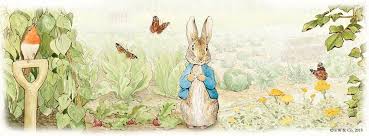
Beatrix used her earnings from the ‘little books’ to leave her over powering parents and and unhappy loss to purchase a small farm, Hill Top in the northwest area of England. 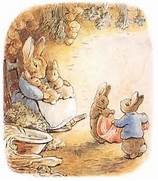 Her love of sheep and breeding filled her life with farming. She again found love in her solicitor, William Heelis who shared her love of the Hill Top farm and farming. They would enjoy a long and happy thirty years of marriage.
Her love of sheep and breeding filled her life with farming. She again found love in her solicitor, William Heelis who shared her love of the Hill Top farm and farming. They would enjoy a long and happy thirty years of marriage.
When Beatrix Potter moved to the country and began farming she painted exquisite watercolors for her books. Most of these books depict the surrounding north-country farming life. But by the age of fifty-six Potter’s creative period was nearly over and she devoted her time to sheep farming. Over the years she became well known as a breeder of Herdwick sheep. She purchased several more farms over the years until at the time of her death on December 22, 1943 she was a substantial landowner.
Sister Anne was the last of Potter’s books to be printed during her lifetime. Two more titles, Wag-by Wag and The Tale of the Faithful Dove were printed posthumously.

In their resource guide on Beatrix Potter, Sayre G. Turney, Michelle Frisque, Beth Kean and Elizabeth T. Mahoney explore the life and publishing career of Miss Potter. Their site can be found at: http://yorktown.library.pitt.edu/libraries/is/enroom/illustrators/potter.htm It is a through site with color pictures, bibliography, biography, works by Miss Potter and examples of her journal.





